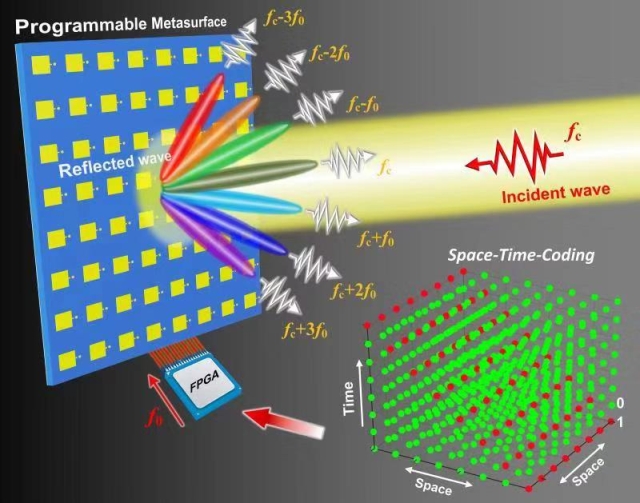The field of ‘metamaterials’ and ‘metasurfaces’ has seen tremendous growth in recent years, because of its ability to induce physical responses absent in nature, including invisibility cloaks and flat lenses.
A study by researchers at Southeast University (Nanjing, China) and the University of Sannio (Benevento, Italy) has put forward the idea of space-time-coding digital metasurfaces, which promises new advances in wireless communications, cognitive radars and imaging systems.

The study, published in the journal Nature Communications, was led by Tie Jun Cui, Professor at the State Key Laboratory of Millimeter Waves and the Synergetic Innovation Center of Wireless Communication Technology of Southeast University, and Vincenzo Galdi, Associate Professor in the Fields & Waves Lab, Department of Engineering, University of Sannio. The research team included Lei Zhang, Xiao Qing Chen, Shuo Liu, Qian Zhang, Jie Zhao, Jun Yan Dai, Guo Dong Bai, Xiang Wan, and Qiang Cheng from Southeast University, and Giuseppe Castaldi from the University of Sannio.
“Conventional metamaterials and metasurfaces are typically realized by gradually changing the properties of small inclusions in a host medium.” Cui said. “However, in 2014, our Group was among the first to propose the idea of ‘digital coding’ metamaterials, relying on a limited number of (e.g., only two) inclusion types. Besides greatly simplifying the design process, this concept has built a bridge between the physical and digital worlds, making it possible to revisit metamaterials from the perspective of information science. Most importantly, the description of metamaterials in terms of ‘coding’ is naturally suitable to the integration with active elements, such as diodes or micro-electro-mechanical systems, which can be controlled by an integrated circuit so that a number of functionalities can actually be programmed (and re-programmed), in a fashion similar to the software that operates our smartphones and personal computers.”
“So far, however, the concept of ‘coding’ has been applied only to the spatial dimensions. In the simplest case, one can view a ‘coding’ metasurface as a pixelated image, where each pixel represents an inclusion type and is associated to a ‘1’ or ‘0’ bit.” Galdi explained. “On the other hand, the temporal dimension has not been considered. In our study, we showed that the same hardware that was used for ‘programming’ a metasurface could also be used for switching the ‘1/0’ bits very fast in time, and this temporal-coding mechanism enables a wealth of new interesting functionalities. Moreover, it could also be exploited to effectively attain conventional spatial coding, but with a much lower hardware complexity.”
As proof-of-concept examples, the researchers showed that the spatio-temporal coding could be optimized so as to effectively spread an incident beam across all possible directions and the whole frequency spectrum, which could be very useful for the reduction/control of scattering signatures as well as for novel computational-imaging schemes which are currently being explored for airport body scanners. Moreover, they showed that it is possible to re-radiate specific frequencies along desired directions, in a precise, controllable fashion, which may find interesting applications in high-capacity multiple-input-multiple-output communication systems. Besides validating their theory with computer simulations, they also fabricated and tested a microwave prototype working at 10 GHz, which confirmed the theoretical predictions.
“We envision the future metamaterials to integrate several complex ‘software-defined’ functionalities (e.g., communications, radar, imaging) and to implement environmentally reactive and ‘cognitive’ capabilities.” Cui and Galdi concluded. “We believe that the space-time coding may play a key role in the evolution toward these architectures.”

Conceptual illustration of a space-time-coding digital metasurface. The electromagnetic response of each element (yellow square patches) can be switched via a diode between two possible states, associated with the 0/1 bits. The switching is controlled in space and time by an integrated circuit (e.g. field-programmable gate array, FPGA), according to a given coding (represented by the 3-D matrix of red and green dots) which can be designed and optimized so as to perform a desired manipulation. For instance, for a given impinging beam, the metasurface can re-radiate multiple beams at different frequencies and directions, in a controllable fashion.
For more details: http://www.nature.com/articles/s41467-018-06802-0
Please address correspondence to: Tie Jun Cui (tjcui@seu.edu.cn) or Vincenzo Galdi (vgaldi@unisannio.it).


